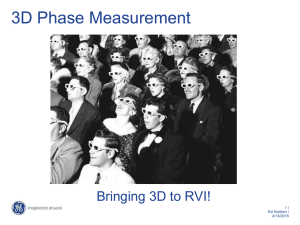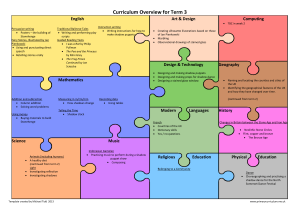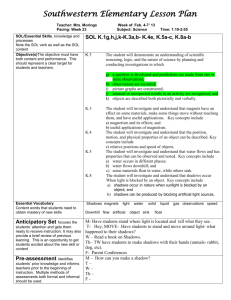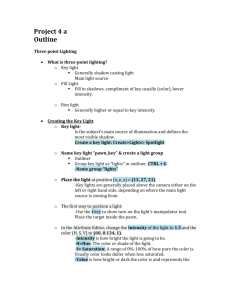Sun and Shadows: Lesson Plans & Experiments for Grades 4-5
advertisement
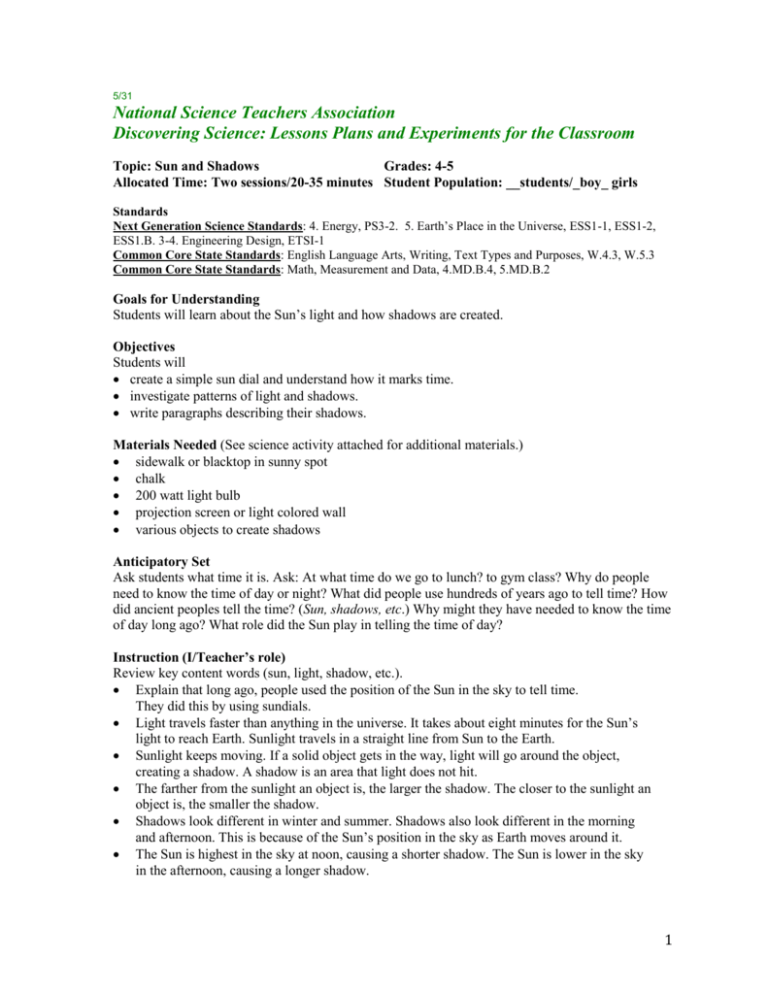
5/31 National Science Teachers Association Discovering Science: Lessons Plans and Experiments for the Classroom Topic: Sun and Shadows Grades: 4-5 Allocated Time: Two sessions/20-35 minutes Student Population: __students/_boy_ girls Standards Next Generation Science Standards: 4. Energy, PS3-2. 5. Earth’s Place in the Universe, ESS1-1, ESS1-2, ESS1.B. 3-4. Engineering Design, ETSI-1 Common Core State Standards: English Language Arts, Writing, Text Types and Purposes, W.4.3, W.5.3 Common Core State Standards: Math, Measurement and Data, 4.MD.B.4, 5.MD.B.2 Goals for Understanding Students will learn about the Sun’s light and how shadows are created. Objectives Students will create a simple sun dial and understand how it marks time. investigate patterns of light and shadows. write paragraphs describing their shadows. Materials Needed (See science activity attached for additional materials.) sidewalk or blacktop in sunny spot chalk 200 watt light bulb projection screen or light colored wall various objects to create shadows Anticipatory Set Ask students what time it is. Ask: At what time do we go to lunch? to gym class? Why do people need to know the time of day or night? What did people use hundreds of years ago to tell time? How did ancient peoples tell the time? (Sun, shadows, etc.) Why might they have needed to know the time of day long ago? What role did the Sun play in telling the time of day? Instruction (I/Teacher’s role) Review key content words (sun, light, shadow, etc.). Explain that long ago, people used the position of the Sun in the sky to tell time. They did this by using sundials. Light travels faster than anything in the universe. It takes about eight minutes for the Sun’s light to reach Earth. Sunlight travels in a straight line from Sun to the Earth. Sunlight keeps moving. If a solid object gets in the way, light will go around the object, creating a shadow. A shadow is an area that light does not hit. The farther from the sunlight an object is, the larger the shadow. The closer to the sunlight an object is, the smaller the shadow. Shadows look different in winter and summer. Shadows also look different in the morning and afternoon. This is because of the Sun’s position in the sky as Earth moves around it. The Sun is highest in the sky at noon, causing a shorter shadow. The Sun is lower in the sky in the afternoon, causing a longer shadow. 1 Guided Practice (We/Students with Teacher’s guidance) Assign groups of students to work together. In a sunny spot ask students to hold one hand above a sidewalk or blacktop. Ask: Do you see shadows? Let students move their hands to see the shadows move. Ask students to predict how they can make their shadows grow bigger or smaller. Students can then move closer or farther away. Were the predictions correct? Let students take turns outlining their shadows with chalk and to decorate the outlines as they stand in different positions. Review and Summary Create a shadow word web, which could be used to facilitate writing about shadows. On an easel pad, write the word shadow in a circle. Extend six to eight lines from the circle. Ask: What words describe about shadows. Record the words on the lines. (darkness, shapes, gray, trace, dim, etc.) Independent Learning (You/Student) Ask students to write paragraphs about their shadows. They should include a main idea and details about shadows, and reflect on their experiences about light, shapes, sizes, etc. while making shadows outdoors. Remind students to use the shadow web words. Checking for Understanding (Assessing) Review students’ paragraphs for accuracy and creativity. Cross Curriculum Extension: Math/Science Let students analyze the size of a shadow as it relates to the distance of an object from a light source, using a 200-watt light bulb. On an easel pad, students should create a four-column table. They should set the object a fixed distance from the light to a screen or white wall. They should record the following in each column. Column 1: the distance in the first column of the table. Column 2: record the measurements as they change the distance of the object from the light several times, moving it farther away each time. Column 3: the height of each object used should be the same. Column 4: the height of the shadow formed each time they moved the object farther away from the light. Ask: What happened each time you moved the object farther away? What pattern do you see in shadow size? Adaptation (Gifted and Talented or English Language Learners) Ask students to explore the many aspects of the Sun—its energy, power, heat, light, and danger. Encourage students to write cinquain poems about the Sun. Cinquain poems are five-line poems meant to convey emotion or mood. The form of a cinquain is often: first line: one word (title), second line: two describing words; third line: three action words, fourth line: four words that show feeling about the subject; fifth line: one word that is a synonym for the title word. Additional Reading Shadow, by Suzy Lee Solar Energy: Running on Sunshine, by Amy Hansen Sunlight, by Erin Edison Super Shadows, by Nadia Higgins Additional Resources National Science Teachers Association Science and Children, “Talking about Shadows,” October 2012, pages 32-34. learningcenter.nsta.org/product_detail.aspx?id=10.2505/4/sc12_050_02_32S See examples of formats of cinquain poems at http://hrsbstaff.ednet.ns.ca/davidc/6c_files/Poem%20pics/cinquaindescrip.htm 2 For the history of telling time, see http://www.time-for-time.com/history.htm NSTA Discovering Science Grades: 4-5 Title: The Sun Demonstration: How Can You Use the Sun and Shadows to Tell Time? Standards: Next Generation Science Standards: Earth and Space Sciences, Earth’s Place in the Universe, ESS1.A, Physical Sciences, Energy PS3.B What you need stick sunny, flat outdoors spot clock 10-12 rocks about 3 to 5 inches wide Time: 10-12 hours What you do 1. Push the stick into the ground in a sunny place. 2. Check the clock. When it is 7 a.m., place a rock at the end of where the shadow falls. 3. Write 7 a.m. on the rock. 4. Repeat this every hour, on the hour, until 5 p.m. 5. Label each stone with the corresponding hour of day. 6. To tell time, look at the shadow caused by the stick. Which stone is it on? If the shadow is halfway between two stones it would be half past the hour. How did you do? Is the time correct? What you found You can tell the time by viewing the shadow cast by the Sun as it shines on the stick of a sundial at different times of the day. In the early morning and late afternoon the Sun is lower on the horizon. This makes shadows appear longer. At midday, the Sun is almost overhead. This makes shadows appear shorter. Note: Early civilizations, including the Egyptians, Greeks, and Romans, are credited with using a stick as a device to tell time. The stick, called a gnomon, (nom-on), is the basic part of a sundial. It is the part that casts the shadow. Conclusion The angle of the Sun on the horizon changes during the day. The Sun’s angle determines the length of the shadow cast by the sundial’s stick. The shadow enables you to tell the time of day. Explore More! Find out how we get day and night. Gather a lamp (the Sun) and an orange (Earth), and go into a dark room (space). Hold the orange in front of the lamp. You’ll see only half of it is illuminated. This represents day. The other half of the orange is dark. This represents night. Stick a straight pin partway into the orange. You are marking a place on Earth. Spin the orange on an imaginary axis 3 in front of the Sun. Do you see how the spot you pinned on Earth gets both day and night? What happens at the imaginary poles? Do they get day and night? Name _____________________________________________________________________ NSTA Be a Scientist: Ask, Answer, and Discover! Sketch the stick of the sundial and its shadow in the early morning and indicate the time. Sketch the stick of the sundial and its shadow sometime in the afternoon, and indicate the time. 1. People used Sun to help them tell time long ago. How else might people have used the Sun? ________________________________________________________________________ ________________________________________________________________________ 2. Write one fact about the Sun or shadows. Write one opinion about the Sun or shadows. Fact: _________________________________________________________________________ Opinion: _________________________________________________________________________ 3. Drawing conclusions. Based on what you observed and learned in the experiment above, what can you conclude about why shadows change and why they seem to move? ___________________________________________________________________________ ___________________________________________________________________________ 4. Many ancient cultures used sundials. People eventually determined that noon was when the Sun was directly overhead and shadows of people and objects were at their shortest. As technology advanced, people began to use clocks and watches instead of sundials. Yet, many people still checked the time by using a sundial. Often, clock towers were erected in the center of town to ensure that everyone used the same time. Why do you think people continued to check sundials to verify the time? 4 ___________________________________________________________________________ ___________________________________________________________________________ ___________________________________________________________________________ 5

